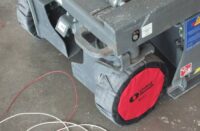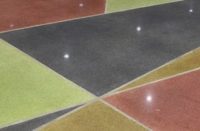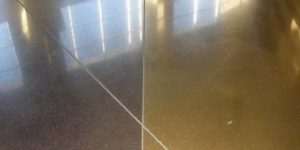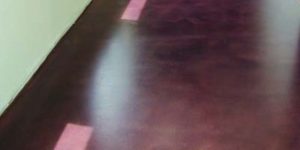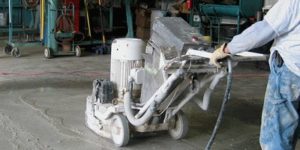Densifiers are an underutilized, misunderstood and overlooked key to producing a beautiful and durable polished concrete floor. During the 1990s many beautiful floors were polished without densifier, and they quickly developed signs of wear, especially the loss of that durable shine. Since then densifier has become a staple when polishing concrete, but my experience daily tells me that most polishers have little to no clue why.
These silicate solutions are known by several names: densifier, hardener, penetrating reactive sealer, permanent protection, dust-proofer, water-repellant. In this article I will refer to this chemical as a densifier.
When a concrete slab is ground, honed, and polished, the diamonds will scratch the surface of the concrete. Whether the scratches are deep and wide from 30/40 metal bonds or shallower from gentler-cutting 50 hybrids, the result is that diamonds create valleys (scratches) in the hard concrete with edges along both sides and exposed pores everywhere. The pores have variable sizes — some run directly into a piece of aggregate (rock or sand) and some connect to another capillary just underneath the surface.
Think of the scratch valleys (the scratch patterns) like you think about expansion joints, saw cuts or cracks. The reason we fill that void is because the edges are the most vulnerable parts of the concrete. Filling the voids with a semirigid material allows the vulnerable, brittle and weak edges to be supported and protected.
Picture a structural crack on an old slab. Most likely some of the edges have broken away in high-traffic areas, resulting in a crack that has widened over time. This is spalling. Now think about the expansion joints or saw cuts on a slab — the same thing occurs there. Spalling can occur when an object strikes the edge repeatedly or even once hard enough to cause damage.
In the early days of polishing, it was typical to fill the joints at the end of the job. Over time, joint sealant manufacturers noticed this problem and developed new technology that hardens quicker and does not smear when exposed to high heat from the diamonds. This allows for earlier filling and better joint protection, and I believe that this is the reason why most experienced polishers fill their joints after their first cut today.
Now, what does porosity of the concrete really mean? Think of concrete as a really hard sponge, and picture its pores. They too have edges, and these edges are also vulnerable, brittle and weak. The same conditions that damage a joint or saw cut will also cause damage to the edge of a concrete pore. If the concrete pores are not protected, some of those vulnerable pore edges will break. When we speak about a slab “dusting,” this is where the dust is coming from.
Since we cannot fill each pore with joint sealant, how can we protect the vulnerable edges of the concrete pores?
The answer is densifier. Densifier applied to rejection will supply that protection to the valley edges of the scratches and to the concrete pores themselves.
Why concrete seems thirsty
Densifiers are either alkali metal silicates or colloidal silica. When your choice of densifier is applied to the concrete and absorbs into the concrete slab, the silicate reacts with the free lime (excess calcium hydroxide) and forms calcium silicate hydrate (CSH), which adds to the CSH formed in the hydration of portland cement.
The reason these products are called densifier is that the CSH compound fills the concrete pores, increasing strength, hardness, and mass per volume. Each densifier reaction fills a little bit more, so I recommend densification to rejection to fully protect those vulnerable valley edges.
Just because the densifier has been applied evenly, penetrated, and dried in the concrete does not mean that your job is done. Concrete varies in porosity throughout a slab. When one area quits absorbing densifier, the dry area next to it may still be absorbing densifier. Think of the areas around columns, the edges, the areas with more aggregate exposed, and the areas that were higher when you ground the floor so that your grinder did not run as smoothly. These porous areas tend to absorb densifier faster and take a greater quantity. They will need to be detailed by your continuing to apply or redistribute more densifier. It is extremely important to keep redistributing the densifier from the areas that are wet to the areas that are dry. You want to quench that concrete’s thirst!
Your job is done when the concrete has absorbed the silicate solution across the entire slab and dries out at the same rate.
I also want to clear up the common misconception that when a densifier gels, it is because it has reacted with the concrete and the slab has chemically absorbed all the densifier it can. This notion is incorrect.
All densifiers are silicate blended in a solution of water, with a variety of surfactants, wetting agents, performance additives and “secret ingredients.” The thing that all densifiers have in common is that as their water begins to evaporate, they get thicker and change from liquids to gels. For most brands of densifier, simply adding more water to the slick gel will allow it to go back into solution. Then the densifier can continue to penetrate and react. When you scrub and pick up the densifier because it gelled, you are wasting money and underdensifying the concrete. The concrete is not done drinking. It is just that the densifier became too thick.
Application tips and thoughts
In the 15 years that I have been densifying slabs, I have found some common threads. After about 20 minutes the concrete seems to quit taking the densifier. By performing some intimate contact like scrubbing, I break the surface tension and the densifier will start to penetrate again — that is, if it is still in a liquid state. If it’s not, add water first and then break the surface tension.
The movement can be accomplished with a microfiber pad, a soft nylon-bristle push broom, or a nylon brush on a scrubber. I prefer the broom because the silicate flows through the bristles and does not build up like it does when using a pad.
Once the surface tension is broken the concrete will take densifier for 20 to 40 more minutes, with continued redistribution. Then, do an evaluation. If most of the material has penetrated, redistribute the remaining product from the wetter areas to the drier areas. Add water to the slick areas, spread out evenly and let dry.
If all material has absorbed, there’s no need to wash the slab.
Lastly, I am often asked: Why not pour all of the densifier onto the concrete slab at once?
The answer is because if ALL of the densifier does not penetrate, you will have to add water if it gets slick or it stops penetrating, and at that point the clear water and the clear densifier look the same. If instead, less is applied and all of that penetrates, then you know you have achieved some kind of coverage rate.
We all want to see polished concrete live up to its marketing claims of durability, sustainability, and low life-cycle cost. Applying densifier to rejection will benefit the concrete and help make that job much easier.
When Are You Done Densifying?
How can you tell that the slab has been densified to rejection and you can stop applying it?
• Densifier has been applied for a minimum of one hour.
• Any areas that have gotten slippery have been diluted and redistributed.
• The concrete is about the same color across the entire surface.
• The crazing/spider/shrinkage cracks have been filled and are no longer as pronounced.
• You twist your foot on the dry densified concrete and it squeaks.
• You’ve reached the recommended coverage rate for the square footage of your slab. (Make sure to measure the square footage before you apply the densifier)
• When done densifying, you check to see how many gallons were applied, and the number is close to the specified quantity. If it isn’t, keep applying until the quantity gets closer.
One last tip: Sometimes waiting a few hours or overnight and densifying again allows the slab to drink in much more densifier.

